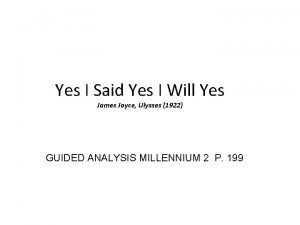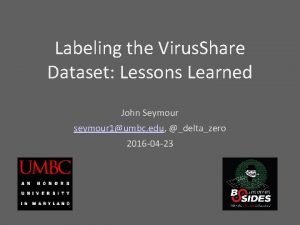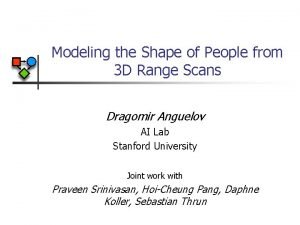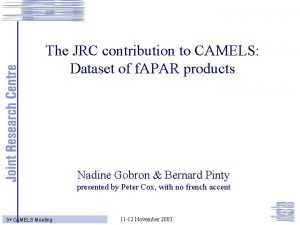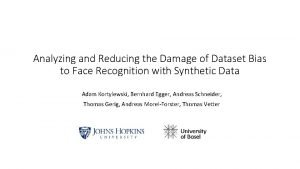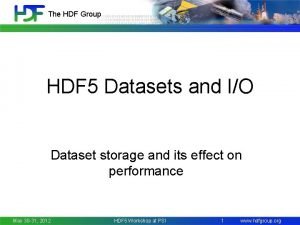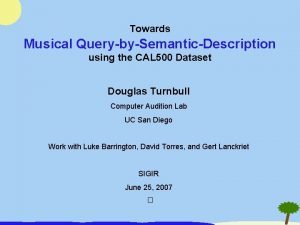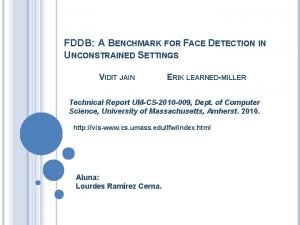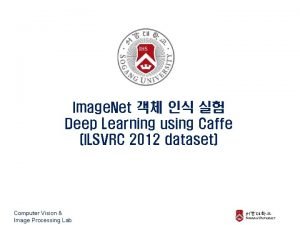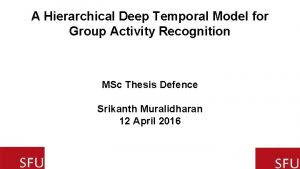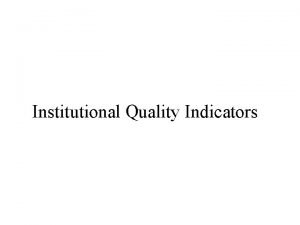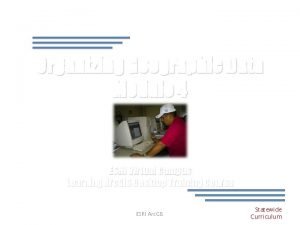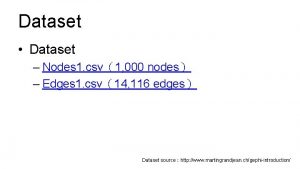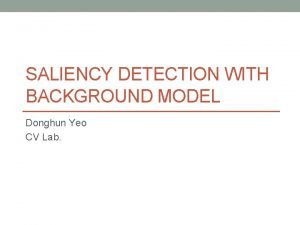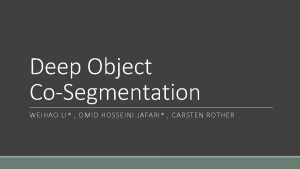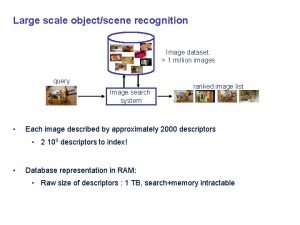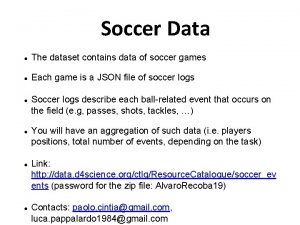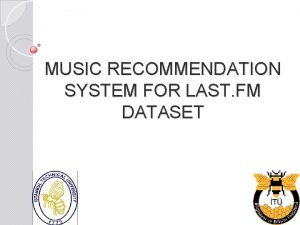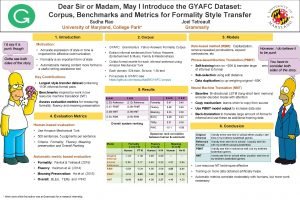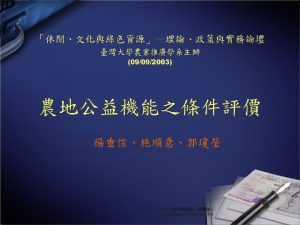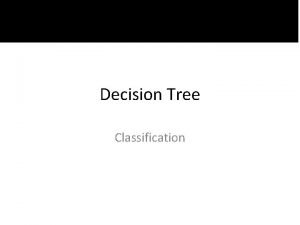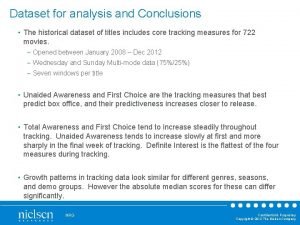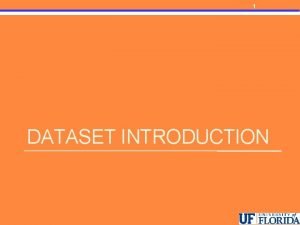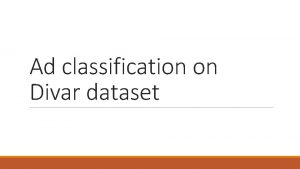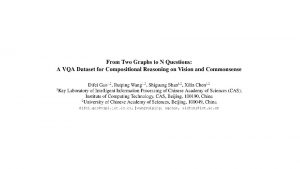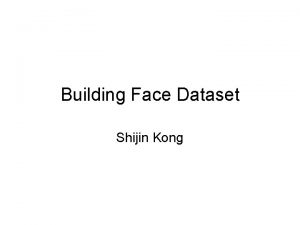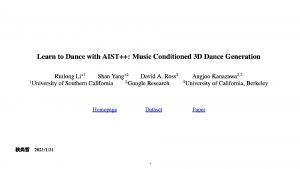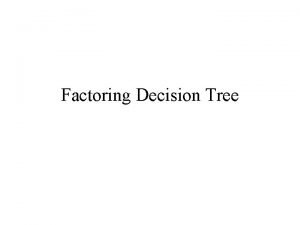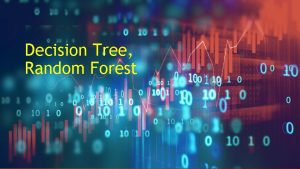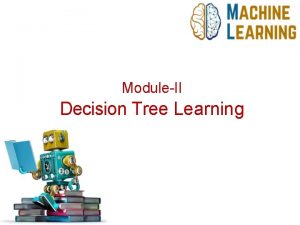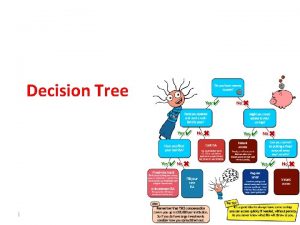DECISION TREE DECISION TREE DATASET no no yes






![X = balance_data. values[: , 1: 5] Y = balance_data. values[: , 0] print X = balance_data. values[: , 1: 5] Y = balance_data. values[: , 0] print](https://slidetodoc.com/presentation_image_h2/84cb56d959ff333accc2d3ad3c5eba13/image-7.jpg)

![y_pred = clf_entropy. predict(X_test) print(y_pred) ['yes' 'yes'] y_pred = clf_entropy. predict(X_test) print(y_pred) ['yes' 'yes']](https://slidetodoc.com/presentation_image_h2/84cb56d959ff333accc2d3ad3c5eba13/image-9.jpg)

![print(clf_entropy. predict([[6, 75, 70, 1]])) ['yes'] print(clf_entropy. predict([[6, 75, 70, 1]])) ['yes']](https://slidetodoc.com/presentation_image_h2/84cb56d959ff333accc2d3ad3c5eba13/image-11.jpg)






![X = balance_data. values[: , 1: 5] Y = balance_data. values[: , 0] print X = balance_data. values[: , 1: 5] Y = balance_data. values[: , 0] print](https://slidetodoc.com/presentation_image_h2/84cb56d959ff333accc2d3ad3c5eba13/image-18.jpg)

![y_pred = model. predict(X_test) print(y_pred) ['no' 'yes'] y_pred = model. predict(X_test) print(y_pred) ['no' 'yes']](https://slidetodoc.com/presentation_image_h2/84cb56d959ff333accc2d3ad3c5eba13/image-20.jpg)
![print(model. predict([[2, 71, 91, 1]])) ['no'] print(model. predict([[2, 71, 91, 1]])) ['no']](https://slidetodoc.com/presentation_image_h2/84cb56d959ff333accc2d3ad3c5eba13/image-21.jpg)


![print(metrics. confusion_matrix(y_test, y_pred)) [[1 1] [1 2]] print(metrics. confusion_matrix(y_test, y_pred)) [[1 1] [1 2]]](https://slidetodoc.com/presentation_image_h2/84cb56d959ff333accc2d3ad3c5eba13/image-24.jpg)



![X = np. array([[1, 2], [5, 8], [1. 5, 1. 8], [8, 8], [1, X = np. array([[1, 2], [5, 8], [1. 5, 1. 8], [8, 8], [1,](https://slidetodoc.com/presentation_image_h2/84cb56d959ff333accc2d3ad3c5eba13/image-28.jpg)
![print(clf. predict([[0. 58, 0. 76]])) [0] print(clf. predict([[10. 58, 10. 76]])) [1] print(clf. predict([[0. 58, 0. 76]])) [0] print(clf. predict([[10. 58, 10. 76]])) [1]](https://slidetodoc.com/presentation_image_h2/84cb56d959ff333accc2d3ad3c5eba13/image-29.jpg)











![pred_values=[lin_reg. coef_ * i + lin_reg. intercept_ for i in height] plt. xlabel("height") plt. pred_values=[lin_reg. coef_ * i + lin_reg. intercept_ for i in height] plt. xlabel("height") plt.](https://slidetodoc.com/presentation_image_h2/84cb56d959ff333accc2d3ad3c5eba13/image-41.jpg)
![w 1=lin_reg. predict(np. array([[10. 2]])) print("the weight is", w 1) the weight is [103. w 1=lin_reg. predict(np. array([[10. 2]])) print("the weight is", w 1) the weight is [103.](https://slidetodoc.com/presentation_image_h2/84cb56d959ff333accc2d3ad3c5eba13/image-42.jpg)







![X_train, X_test, y_train, y_test = train_test_split( df[['age']], df. insurance, test_size=0. 1) model=Logistic. Regression() model. X_train, X_test, y_train, y_test = train_test_split( df[['age']], df. insurance, test_size=0. 1) model=Logistic. Regression() model.](https://slidetodoc.com/presentation_image_h2/84cb56d959ff333accc2d3ad3c5eba13/image-50.jpg)
![m 2=model. predict([[35]]) print(m 2) [1] m 2=model. predict([[35]]) print(m 2) [1]](https://slidetodoc.com/presentation_image_h2/84cb56d959ff333accc2d3ad3c5eba13/image-51.jpg)
- Slides: 51

DECISION TREE

DECISION TREE

DATASET no no yes yes yes no 6 6 4 2 2 2 4 6 6 2 6 4 4 2 85 80 83 70 68 65 64 72 69 75 75 72 81 71 85 90 86 96 80 70 65 95 70 80 70 90 75 91 0 0 0 1 1 0 1

import numpy as np import pandas as pd from sklearn. model_selection import train_test_split from sklearn. tree import Decision. Tree. Classifier from sklearn. metrics import accuracy_score

balance_data = pd. read_csv('C: Pythonweather. csv', header= None) print(balance_data) 0 1 2 3 4 0 no 6 85 85 0 1 no 6 80 90 1 2 yes 4 83 86 0 3 yes 2 70 96 0 4 yes 2 68 80 0 5 no 2 65 70 1 6 yes 4 64 65 1 7 no 6 72 95 0 8 yes 6 69 70 0 9 yes 2 75 80 0 10 yes 6 75 70 1 11 yes 4 72 90 1 12 yes 4 81 75 0 13 no 2 71 91 1

print("Dataset Lenght: : ", len(balance_data)) print("Dataset Shape: : ", balance_data. shape) Dataset Lenght: : 14 Dataset Shape: : (14, 5)
![X balancedata values 1 5 Y balancedata values 0 print X = balance_data. values[: , 1: 5] Y = balance_data. values[: , 0] print](https://slidetodoc.com/presentation_image_h2/84cb56d959ff333accc2d3ad3c5eba13/image-7.jpg)
X = balance_data. values[: , 1: 5] Y = balance_data. values[: , 0] print (X, Y) [[6 85 85 0] [6 80 90 1] [4 83 86 0] [2 70 96 0] [2 68 80 0] [2 65 70 1] [4 64 65 1] [6 72 95 0] [6 69 70 0] [2 75 80 0] [6 75 70 1] [4 72 90 1] [4 81 75 0] [2 71 91 1]] ['no' 'yes' 'yes' 'yes' 'no']

X_train, X_test, y_train, y_test = train_test_split( X, Y, test_size = 0. 3, random_state = 100) clf_entropy = Decision. Tree. Classifier(criterion = "entropy", random_state = 100, max_depth=3, min_samples_leaf=5) clf_entropy. fit(X_train, y_train)
![ypred clfentropy predictXtest printypred yes yes y_pred = clf_entropy. predict(X_test) print(y_pred) ['yes' 'yes']](https://slidetodoc.com/presentation_image_h2/84cb56d959ff333accc2d3ad3c5eba13/image-9.jpg)
y_pred = clf_entropy. predict(X_test) print(y_pred) ['yes' 'yes']

print("Accuracy is ", accuracy_score(y_test, y_pred)*100) Accuracy is 60. 0
![printclfentropy predict6 75 70 1 yes print(clf_entropy. predict([[6, 75, 70, 1]])) ['yes']](https://slidetodoc.com/presentation_image_h2/84cb56d959ff333accc2d3ad3c5eba13/image-11.jpg)
print(clf_entropy. predict([[6, 75, 70, 1]])) ['yes']

Naïve Bayes classifier

Bayes’ Theorem

import numpy as np import pandas as pd from sklearn. model_selection import train_test_split from sklearn. naive_bayes import Gaussian. NB from sklearn. metrics import accuracy_score from sklearn import metrics

balance_data = pd. read_csv('C: Pythonweather. csv', header= None) print(balance_data) 0 1 2 3 4 0 no 6 85 85 0 1 no 6 80 90 1 2 yes 4 83 86 0 3 yes 2 70 96 0 4 yes 2 68 80 0 5 no 2 65 70 1 6 yes 4 64 65 1 7 no 6 72 95 0 8 yes 6 69 70 0 9 yes 2 75 80 0 10 yes 6 75 70 1 11 yes 4 72 90 1 12 yes 4 81 75 0 13 no 2 71 91 1

balance_data = pd. read_csv('C: Pythonweather. csv', header= None) print(balance_data) 0 1 2 3 4 0 no 6 85 85 0 1 no 6 80 90 1 2 yes 4 83 86 0 3 yes 2 70 96 0 4 yes 2 68 80 0 5 no 2 65 70 1 6 yes 4 64 65 1 7 no 6 72 95 0 8 yes 6 69 70 0 9 yes 2 75 80 0 10 yes 6 75 70 1 11 yes 4 72 90 1 12 yes 4 81 75 0 13 no 2 71 91 1

print("Dataset Lenght: : ", len(balance_data)) print("Dataset Shape: : ", balance_data. shape) Dataset Lenght: : 14 Dataset Shape: : (14, 5)
![X balancedata values 1 5 Y balancedata values 0 print X = balance_data. values[: , 1: 5] Y = balance_data. values[: , 0] print](https://slidetodoc.com/presentation_image_h2/84cb56d959ff333accc2d3ad3c5eba13/image-18.jpg)
X = balance_data. values[: , 1: 5] Y = balance_data. values[: , 0] print (X, Y) [[6 85 85 0] [6 80 90 1] [4 83 86 0] [2 70 96 0] [2 68 80 0] [2 65 70 1] [4 64 65 1] [6 72 95 0] [6 69 70 0] [2 75 80 0] [6 75 70 1] [4 72 90 1] [4 81 75 0] [2 71 91 1]] ['no' 'yes' 'yes' 'yes' 'no']

X_train, X_test, y_train, y_test = train_test_split( X, Y, test_size = 0. 3, random_state = 100) model = Gaussian. NB() model. fit(X_train, y_train)
![ypred model predictXtest printypred no yes y_pred = model. predict(X_test) print(y_pred) ['no' 'yes']](https://slidetodoc.com/presentation_image_h2/84cb56d959ff333accc2d3ad3c5eba13/image-20.jpg)
y_pred = model. predict(X_test) print(y_pred) ['no' 'yes']
![printmodel predict2 71 91 1 no print(model. predict([[2, 71, 91, 1]])) ['no']](https://slidetodoc.com/presentation_image_h2/84cb56d959ff333accc2d3ad3c5eba13/image-21.jpg)
print(model. predict([[2, 71, 91, 1]])) ['no']

print("Accuracy is ", accuracy_score(y_test, y_pred)*100) Accuracy is 60. 0

print(metrics. classification_report(y_test, y_pred)) precision recall f 1 -score support no yes 0. 50 0. 67 micro avg 0. 60 macro avg 0. 58 weighted avg 0. 60 0. 50 0. 67 2 3 0. 60 0. 58 0. 60 5 5 5
![printmetrics confusionmatrixytest ypred 1 1 1 2 print(metrics. confusion_matrix(y_test, y_pred)) [[1 1] [1 2]]](https://slidetodoc.com/presentation_image_h2/84cb56d959ff333accc2d3ad3c5eba13/image-24.jpg)
print(metrics. confusion_matrix(y_test, y_pred)) [[1 1] [1 2]]

SVM (SUPPORT VECTOR MACHINE)


import numpy as np import matplotlib. pyplot as plt from sklearn import svm x = [1, 5, 1. 5, 8, 1, 9] y = [2, 8, 1. 8, 8, 0. 6, 11] plt. scatter(x, y)
![X np array1 2 5 8 1 5 1 8 8 8 1 X = np. array([[1, 2], [5, 8], [1. 5, 1. 8], [8, 8], [1,](https://slidetodoc.com/presentation_image_h2/84cb56d959ff333accc2d3ad3c5eba13/image-28.jpg)
X = np. array([[1, 2], [5, 8], [1. 5, 1. 8], [8, 8], [1, 0. 6], [9, 11]]) y = [0, 1, 0, 1] clf = svm. SVC(kernel='linear') clf. fit(X, y)
![printclf predict0 58 0 76 0 printclf predict10 58 10 76 1 print(clf. predict([[0. 58, 0. 76]])) [0] print(clf. predict([[10. 58, 10. 76]])) [1]](https://slidetodoc.com/presentation_image_h2/84cb56d959ff333accc2d3ad3c5eba13/image-29.jpg)
print(clf. predict([[0. 58, 0. 76]])) [0] print(clf. predict([[10. 58, 10. 76]])) [1]

Introduction to Regression is a parametric technique used to predict continuous (dependent) variable given a set of independent variables. It is parametric in nature because it makes certain assumptions based on the data set. If the data set follows those assumptions, regression gives incredible results. Otherwise, it struggles to provide convincing accuracy. What is Regression? In statistical modeling, regression analysis is a set of statistical processes for estimating the relationships among variables.

Regression model Ø Relation between variables where changes in some variables may “explain” or possibly “cause” changes in other variables. Ø Explanatory variables are termed as independent variables and the variables to be explained are termed as dependent variables. Ø Regression model estimates the nature of the relationship between the independent and dependent variables.

Examples Ø Dependent variable is retail price of gasoline in Regina – independent variable is the price of crude oil. Ø Dependent variable is employment income – independent variables might be hours of work, education, occupation, gender, age, region, years of experience, unionization status, etc. Ø Price of a product and quantity produced or sold: Ø Quantity sold affected by price. Dependent variable is quantity of product sold – independent variable is price. Ø Price affected by quantity offered for sale. Dependent variable is price – independent variable is quantity sold.

Uses of regression Ø Amount of change in a dependent variable that results from changes in the independent variable(s) – can be used to estimate elasticities, returns on investment in human capital, etc. Ø Prediction and forecasting of sales, economic growth, etc. Ø Support or negate theoretical model. Ø Modify and improve theoretical models and explanations of phenomena.

simple linear regression Ø x is the independent variable Ø y is the dependent variable Ø The regression model is Ø The model has two variables, the independent or explanatory variable, x, and the dependent variable y, the variable whose variation is to be explained. Ø The relationship between x and y is a linear or straight line relationship. Ø Two parameters to estimate – the slope of the line β 1 and the y -intercept β 0 (where the line crosses the vertical axis). Ø ε is random, or error component.

Linear Regression

Linear Regression is a machine learning algorithm based on supervised learning. It performs a regression task. Regression, models a target prediction value based on independent variables. It is mostly used for finding out the relationship between variables and forecasting. Different regression models differ based on – the kind of relationship between dependent and independent variables, they are considering and the number of independent variables being used.

Linear regression is used to estimate real world values like cost of houses, number of calls, total sales etc. based on continuous variable. Here, we establish relationship between dependent and independent variables by fitting a best line. This line of best fit is known as regression line and is represented by the linear equation Y= a *X + b. Y – Dependent Variable a – Slope X – Independent variable b – Intercept These coefficients a and b are derived based on minimizing the sum of squared difference of distance between data points and regression line.

import matplotlib. pyplot as plt import numpy as np from sklearn import linear_model height=[[4. 0], [4. 5], [5. 0], [5. 2], [5. 4], [5. 8], [6. 1], [6. 2], [6. 4], [6. 8]] weight=[42, 44, 49, 53, 55, 58, 60, 64, 66, 69]

plt. scatter(height, weight, color='black') plt. xlabel("height") plt. ylabel("weight") plt. show()

lin_reg=linear_model. Linear. Regression() lin_reg. fit(height, weight) m=lin_reg. coef_ b=lin_reg. intercept_ print("slope=", m, "intercept=", b) slope= [10. 25056948] intercept= -0. 7881548974942945
![predvalueslinreg coef i linreg intercept for i in height plt xlabelheight plt pred_values=[lin_reg. coef_ * i + lin_reg. intercept_ for i in height] plt. xlabel("height") plt.](https://slidetodoc.com/presentation_image_h2/84cb56d959ff333accc2d3ad3c5eba13/image-41.jpg)
pred_values=[lin_reg. coef_ * i + lin_reg. intercept_ for i in height] plt. xlabel("height") plt. ylabel("weight") plt. plot(height, pred_values, 'b')
![w 1linreg predictnp array10 2 printthe weight is w 1 the weight is 103 w 1=lin_reg. predict(np. array([[10. 2]])) print("the weight is", w 1) the weight is [103.](https://slidetodoc.com/presentation_image_h2/84cb56d959ff333accc2d3ad3c5eba13/image-42.jpg)
w 1=lin_reg. predict(np. array([[10. 2]])) print("the weight is", w 1) the weight is [103. 76765376]

Logistic Regression


Logistic regression • Logistic regression is another technique borrowed by machine learning from statistics. It is the preferred method for binary classification problems, that is, problems with two class values. • It is a classification algorithm and not a regression algorithm as the name says. It is used to estimate discrete values or values like 0/1, Y/N, T/F based on the given set of independent variable. It predicts the probability of occurrence of an event by fitting data to a logit function. Hence, it is also called logit regression. Since, it predicts the probability, its output values lie between 0 and 1. • Note that taking a log is one of the best mathematical way to replicate a step function.

The following points may be note-worthy when working on logistic regression 1. It is similar to regression in that the objective is to find the values for the coefficients that weigh each input variable. 2. Unlike in linear regression, the prediction for the output is found using a non-linear function called the logistic function. 3. The logistic function appears like a big ‘S’ and will change any value into the range 0 to 1. This is useful because we can apply a rule to the output of the logistic function to assign values to 0 and 1 and predict a class value. 4. The way the logistic regression model is learned, the predictions made by it can also be used as the probability of a given data instance belonging to class 0 or class 1. This can be useful for problems where you need to give more reasoning for a prediction. 5. Like linear regression, logistic regression works better when unrelated attributes of o/p variable is removed and similar attributes are removed.

PYTHON CODE FOR LIGISTIC REGRESSION import pandas as pd import matplotlib. pyplot as plt from sklearn. model_selection import train_test_split from sklearn. linear_model import Logistic. Regression

df = pd. read_csv('C: Pythoninsurance_data. csv') print(df) age insurance 0 22 0 1 25 0 2 47 1 3 52 0 4 46 1 5 56 1 6 55 0 7 60 1 8 62 1 9 61 1 10 18 0 11 28 0 12 27 0 13 29 0 14 49 1 15 55 1 16 25 1 17 58 1 18 19 0 19 18 0 20 21 26 0 22 40 1 23 45 1 24 50 1 25 54 1 26 23 0

plt. scatter(df. age, df. insurance, marker='+', color='red')
![Xtrain Xtest ytrain ytest traintestsplit dfage df insurance testsize0 1 modelLogistic Regression model X_train, X_test, y_train, y_test = train_test_split( df[['age']], df. insurance, test_size=0. 1) model=Logistic. Regression() model.](https://slidetodoc.com/presentation_image_h2/84cb56d959ff333accc2d3ad3c5eba13/image-50.jpg)
X_train, X_test, y_train, y_test = train_test_split( df[['age']], df. insurance, test_size=0. 1) model=Logistic. Regression() model. fit(X_train, y_train) m 1=model. predict(X_test) print(m 1) [1 1 0]
![m 2model predict35 printm 2 1 m 2=model. predict([[35]]) print(m 2) [1]](https://slidetodoc.com/presentation_image_h2/84cb56d959ff333accc2d3ad3c5eba13/image-51.jpg)
m 2=model. predict([[35]]) print(m 2) [1]
 Piccolo yes yes yes
Piccolo yes yes yes Yes she said yes ulysses
Yes she said yes ulysses Yes yes lord amen
Yes yes lord amen Yes yes lord amen
Yes yes lord amen No decision snap decision responsible decision
No decision snap decision responsible decision Slidetodoc.com
Slidetodoc.com Decision tree and decision table examples
Decision tree and decision table examples Virusshare torrent
Virusshare torrent Sliding window detector
Sliding window detector Dataset
Dataset Youtube vos dataset
Youtube vos dataset Cocomo dataset
Cocomo dataset Iris uci dataset
Iris uci dataset Camels dataset
Camels dataset Norb dataset
Norb dataset Cmu panoptic dataset
Cmu panoptic dataset Undoing the damage of dataset bias
Undoing the damage of dataset bias Hdf dataset
Hdf dataset Referit dataset
Referit dataset Eurosat dataset
Eurosat dataset Adam datasets example
Adam datasets example Cal500 dataset
Cal500 dataset Kaggle march madness 2019
Kaggle march madness 2019 Face detection benchmark
Face detection benchmark Ilsvrc-2012
Ilsvrc-2012 Svetlana lazebnik
Svetlana lazebnik Eca&d
Eca&d Cricket bat
Cricket bat Ucd fannie mae
Ucd fannie mae Dataset per esercizi
Dataset per esercizi Balanced and unbalanced dataset
Balanced and unbalanced dataset Cohn kanade dataset
Cohn kanade dataset Volleyball dataset
Volleyball dataset Institutional quality index
Institutional quality index Feature dataset vs feature class
Feature dataset vs feature class Tacred dataset
Tacred dataset Usgs national hydrography dataset
Usgs national hydrography dataset Nodes and edges dataset csv
Nodes and edges dataset csv Bsd300 dataset
Bsd300 dataset Coseg dataset
Coseg dataset Inria holidays dataset
Inria holidays dataset Hansen dataset
Hansen dataset Soccer dataset
Soccer dataset Basicota
Basicota Music recommendation system
Music recommendation system Register dataset azure ml
Register dataset azure ml Dataset multiple linear regression
Dataset multiple linear regression Overfitting and underfitting in data mining
Overfitting and underfitting in data mining Us crime dataset kaggle
Us crime dataset kaggle Virtual memory reddit
Virtual memory reddit Gyafc dataset
Gyafc dataset Yes search engine
Yes search engine

